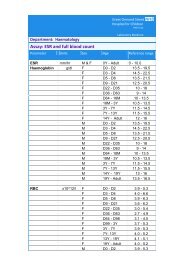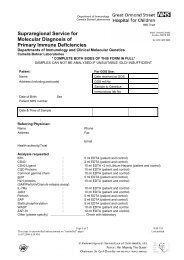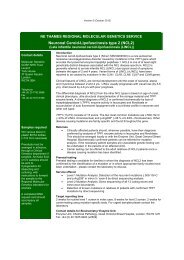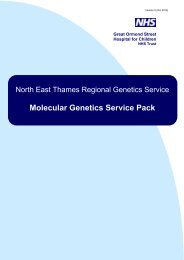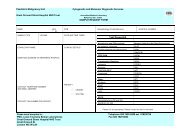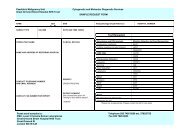Information sheet - Great Ormond Street Hospital Laboratory Medicine
Information sheet - Great Ormond Street Hospital Laboratory Medicine
Information sheet - Great Ormond Street Hospital Laboratory Medicine
- No tags were found...
Create successful ePaper yourself
Turn your PDF publications into a flip-book with our unique Google optimized e-Paper software.
Version 5 (October 2012)NE THAMES REGIONAL MOLECULAR GENETICS SERVICEMetachromatic Leukodystrophy (MLD)& Pseudodeficiency of arylsulphatase A (PDASA)Contact detailsMolecular GeneticsGOSH NHS TrustLevel 6York House37 Queen SquareLondonWC1N 3BHTelephone+44 (0) 20 7762 6888Fax+44 (0) 20 7813 8196Samples required5ml venous blood inplastic EDTA bottles(>1ml from neonates)A completed DNArequest card shouldaccompany allsamples.Contact details forEnzyme Unitundertaking ASAactivity measurements:Enzyme Unit,Chemical Pathology,<strong>Great</strong> <strong>Ormond</strong> <strong>Street</strong><strong>Hospital</strong>, London,WC1N 3JHTel: + 44 (0) 20 74059200 (x2509)IntroductionMetachromatic leukodystrophy (MLD) is an autosomal recessive lysosomal storage disordercaused by deficiency of the enzyme arylsulphatase A which catalyses the first step in thedegradation of the sphingolipid 3-O-Sulphagalactosyl ceramide (sulphatide). Accumulation ofsulphatide in the brain leads to progressive demyelination of the central and peripheralnervous systems causing a variety of neurological symptoms including gait disturbances,ataxias, optical atrophy, dementia, seizures and spastic tetraparesis. Disease severity canrange from mild to severe and can be broadly grouped into 3 subtypes (late-infantile, juvenileand adult).The majority of patients with arylsulphatase A deficiency and signs of MLD will havemutations in the ARSA gene however there is a much less common form of MLD caused bydeficiency of Saposin B, a non-enzymatic sphingolipid activator protein.Arylsulphatase A is also defective in multiple sulphatase deficiency due to mutations inSUMF1. The ARSA gene (22q13.31-qter) comprises 8 exons. Although many novel mutationsare known, there are ‘common’ mutations within the gene, particularly the c.459+1G>A andc.1277C>T (p.Pro426Leu) which account for around 50% of disease alleles in the NorthernEuropean population.Pseudodeficiency of arylsulphatase A (PDASA)Pseudodeficiency of arysulphatase A is a condition of reduced arylsulphatase A activity(G in the 3’UTR, exon 8) destroys the first downstreampolyadenylation site and causes subsequent loss of the 2.1kb mRNA species; this variant isclearly associated with decreased ASA activity. PD2 is almost invariably seen on abackground with PD1. PD1 (c.1788A>G (p.Asn350Ser), exon 6) destroys an N-glycosylationsite, causing a change in protein size, but having little effect on stability or activity. PD1 canoccur independently of PD2 and its effect in causing PDASA is controversial.ReferralsPDASA testing is used to assist the interpretation of arylsulphatase A activity results.Referrals are generally via the Enzyme Unit, <strong>Great</strong> <strong>Ormond</strong> <strong>Street</strong> <strong>Hospital</strong> however referralsmay be accepted from other centres who carry out biochemical testing for arylsulphatase A.Biochemical confirmation of arylsulphatase A deficiency can only be confirmed after PDASAtesting. In families with PDASA, prenatal testing by enzyme analysis can be complicated andin many cases impossible. For these families genetic testing is particularly useful but this canalso mean that in some cases testing for MLD may have to be performed without biochemicalconfirmation. In these cases a very strong clinical picture of MLD must be present.Prenatal testingPrenatal testing is available for families in whom mutations have been identified or in whomappropriate family studies have been undertaken. Prenatal testing for PDASA may also berequested by the Enzyme Unit, <strong>Great</strong> <strong>Ormond</strong> <strong>Street</strong> <strong>Hospital</strong>.Service offered PDASA: Testing for the presence of PD1 and PD2 by direct sequencing. MLD Level 1 Analysis: Detection of the common mutations c.459+1G>A andc.1277C>T (p.Pro426Leu) by direct sequencing. MLD Level 2 Analysis: Direct sequencing of all 8 coding exons and intron-exonboundaries.Target reporting time4 weeks for PDASA testing. 4 weeks for routine level 1 screen in index case, 8 weeks for level2 screen. 2 weeks for routine testing of specific mutations. For urgent samples please contactthe laboratory.
Version 5 (October 2012)Patient detailsTo facilitate accurate testing and reporting please provide patient demographic details (full name, date of birth, addressand ethnic origin), details of any relevant family history and full contact details for the referring clinician



